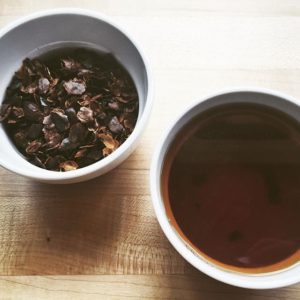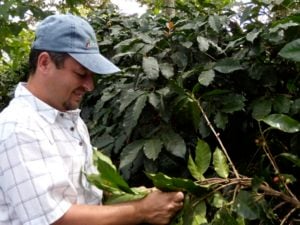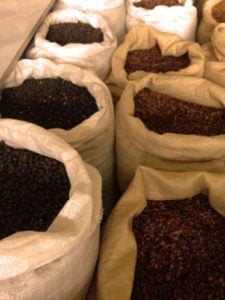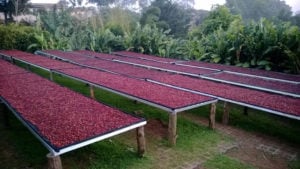We’re very excited to announce a new shipment that just landed from Costa Rica. Las Lajas, our coffee-producing partner from the hills of Costa Rica’s Central Valley, recently sent over this year’s harvest of cascara, the coffee cherry byproduct that also makes for a delicious, tea-like infusion.
Cascara is not, strictly speaking, tea. It comes from the coffee fruit and has a caffeine content somewhere between tea and coffee. It’s made from the dried skin and pulp of the coffee cherry. Different from the cherry’s seed, which yields the coffee beverage, cascara tea is made by steeping dry, leathery flakes in hot water to produce an amber-colored drink.
Cascara tea has a relatively viscous mouthfeel, tastes sweet like honey, and has distinct bright and fruity notes. It could easily be mistaken from afar for a delicately aged whiskey. It’s a simple and complex beverage: paradoxical and unique.
The name cascara translates from Spanish as “husk” or “peel.” After the coffee cherry is picked from the tree, its skin and flesh are separated from the seed. The skin and flesh are often discarded for compost, but some farmers with really sweet coffee fruit think it’s a crazy idea to waste all that deliciousness.
Oscar Chacón from Las Lajas is one such farmer. The Chacón family believes that cascara has a promising future for producers and consumers alike. Both benefit: Farmers are able to monetize what was once a waste product, while consumers can enjoy a great-tasting, antioxidant-rich product.
In an interview, Oscar said, “Truthfully, cascara provides an alternative income for the farm that has allowed for increased investment in the harvest. In turn, the coffee’s quality has improved.”
 Along the process of turning a red coffee cherry into a perfectly roasted bean, an estimated 40% of that cherry is wasted. For every two tons of ready-to-export green coffee, one ton of pulp results as the byproduct. Coffee’s fruit is most often tossed into the compost pile to later be incorporated into the soil. Nevertheless, cascara is a poor fertilizer, lacking significant levels of nitrogen or phosphorus. While composting reduces some waste, the green bean is still the only consumed product. What if the coffee tree could produce two products, the second providing another revenue stream with which farmers could purchase additional inputs for their land, including higher-quality compost?
Along the process of turning a red coffee cherry into a perfectly roasted bean, an estimated 40% of that cherry is wasted. For every two tons of ready-to-export green coffee, one ton of pulp results as the byproduct. Coffee’s fruit is most often tossed into the compost pile to later be incorporated into the soil. Nevertheless, cascara is a poor fertilizer, lacking significant levels of nitrogen or phosphorus. While composting reduces some waste, the green bean is still the only consumed product. What if the coffee tree could produce two products, the second providing another revenue stream with which farmers could purchase additional inputs for their land, including higher-quality compost?
 This “té de café” is an innovative, auxiliary product that we can’t wait to share with our customers. It provides a new form of environmental stability and additional income streams for the most vulnerable in specialty coffee’s supply chain, as well as another connection between consumers and the people behind their coffee at origin. Interested in trying cascara from Las Lajas? Email trade@sustainableharvest.com today for more information.
This “té de café” is an innovative, auxiliary product that we can’t wait to share with our customers. It provides a new form of environmental stability and additional income streams for the most vulnerable in specialty coffee’s supply chain, as well as another connection between consumers and the people behind their coffee at origin. Interested in trying cascara from Las Lajas? Email trade@sustainableharvest.com today for more information.


.png)
